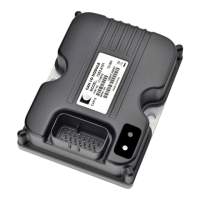APPENDIX A
Curtis 1353 CANopen Expansion Module Manual – June 2017 Return to TOC
pg. 48
APPENDIX A
DESIGN CONSIDERATIONS
ELECTROMAGNETIC COMPATIBILITY (EMC)
Electromagnetic compatibility (EMC) encompasses two areas: emissions and immunity. Emissions are
radio frequency (RF) energy generated by a product. is energy has the potential to interfere with
communications systems such as radio, television, cellular phones, dispatching, aircra, etc. Immunity
is the ability of a product to operate normally in the presence of RF energy. EMC is ultimately a system
design issue. Part of the EMC performance is designed into or inherent in each component; another
part is designed into or inherent in end product characteristics such as shielding, wiring, and layout;
and, nally, a portion is a function of the interactions between all these parts. e design techniques
presented below can enhance EMC performance in products that use Curtis motor controllers.
Emissions
Signals with high frequency content can produce signicant emissions if connected to a large enough
radiating area (created by long wires spaced far apart). PWM drivers can contribute to RF emissions.
Pulse width modulated square waves with fast rise and fall times are rich in harmonics. (Note: PWM
drivers at 100% do not contribute to emissions.) e impact of these switching waveforms can be
minimized by making the wires from the controller to the load as short as possible and by placing
the load drive and return wires near each other.
For applications requiring very low emissions, the solution may involve enclosing the system,
interconnect wires and loads together in one shielded box. Emissions can also couple to battery
supply leads and circuit wires outside the box, so ferrite beads near the controller may also be
required on these unshielded wires in some applications. It is best to keep the noisy signals as far as
possible from sensitive wires.
Immunity
Immunity to radiated electric elds can be improved either by reducing overall circuit sensitivity
or by keeping undesired signals away from this circuitry. e controller circuitry itself cannot be
made less sensitive, since it must accurately detect and process low level signals from sensors such
as the throttle potentiometer. us immunity is generally achieved by preventing the external RF
energy from coupling into sensitive circuitry. is RF energy can get into the controller circuitry
via conducted paths and radiated paths. Conducted paths are created by the wires connected to the
controller. ese wires act as antennas and the amount of RF energy coupled into them is generally
proportional to their length. e RF voltages and currents induced in each wire are applied to the
controller pin to which the wire is connected.
e Curtis 1353 includes bypass capacitors on the printed circuit board’s sensitive input signals to
reduce the impact of this RF energy on the internal circuitry. In some applications, additional ltering
in the form of ferrite beads may also be required on various wires to achieve desired performance
levels. A full metal enclosure can also improve immunity by shielding the 1353 from outside RF
energy.

